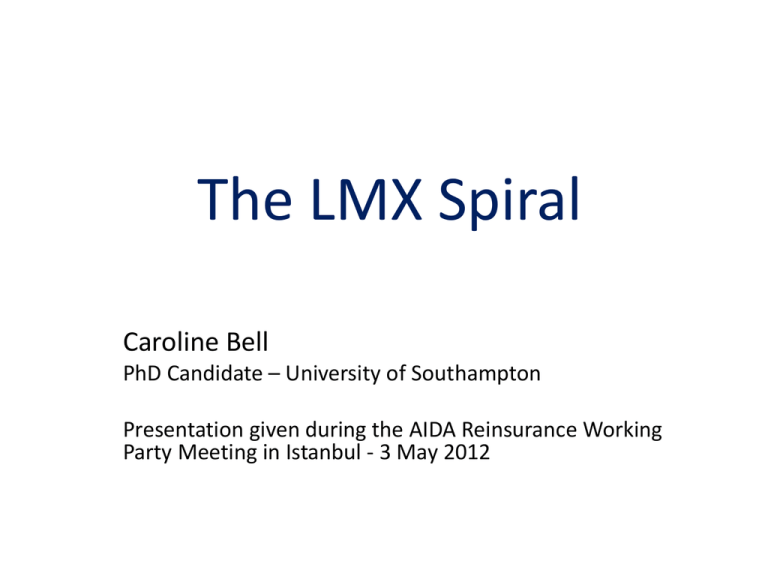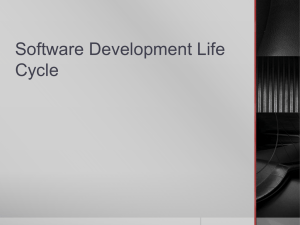The LMX Spiral
advertisement

The LMX Spiral Caroline Bell PhD Candidate – University of Southampton Presentation given during the AIDA Reinsurance Working Party Meeting in Istanbul - 3 May 2012 What was it? In words Aberration Extraordinary Claims’ circles Pathological Pass the Parcel Phenomenon Artificial complexity Can of worms An actuarial perspective... “Spiral Market Net: (...) = R + pa[(l-q)*Xo-R] + lT p*(lq)*Xi . = R + p*[(l-q)*Xo-R] + p*(lq)*Xl/w as R + p*[(l-q)*G-R]” (The Spiral in the Catastrophe Retrocession Market by J Stanard and M Wacek) The Legal definition “Many syndicates which wrote XL cover took out XL cover themselves. Those who reinsured them were thus writing XL on XL. They, in their turn, frequently took out their own XL cover. There thus developed among the syndicates and companies which wrote LMX business a smaller group that was largely responsible for creating a complex intertwining network of mutual reinsurance, which has been described as the spiral.” (Phillips J in Deeny & ors v Gooda Walker Ltd (in voluntary liquidation) & ors [1994] CLC 1224) LMX • LMX = London Market Excess of Loss • Lloyd’s and Companies Market • Nature of the business = standard Excess of Loss (XL) reinsurance contracts • Two main types of contracts: – Specific treaties: covered specific type of risk such as hull, cargo, oil, etc. – “whole account” (aka “generals”) treaties: covered entire portfolio of the cedant’s business London • The London connection: – London was the hub of the LMX Spiral BUT – Risks originated from all over the world – Risks from the London Market could be reinsured outside the UK - they usually (but not always) came back to London. – Leakage: 5% of reinsurance layers were 90% placed (expert report of Mr Bulmer relied upon in Equitas v R&Q Reinsurance Company (UK) Limited [2009] EWHC 2787 (Comm)) LMX Market v LMX Spiral LMX Market XL reinsurance - 2 types: • Risk first reinsured on an XL basis in London (first tier) • XL on XL reinsurances placed in London (second tier and above) • Not all risks within LMX Market were part of the LMX Spiral LMX Spiral • “XL on XL” • Same risk reinsured a second time by the same reinsurer (second tier and above) • Reinsurers outside London participated in the LMX Spiral so LMX Spiral went beyond the London market Spiral? • Not exactly a spiral • “...contained space with all the reinsurers in it connected to each other by multiple lines, representing a multiplicity of relationships on a multiplicity of covers at a multiplicity of levels.” (Ipe Jacob, Project Corkscrew) • Now impossible to replicate (expert evidence in Equitas v R&Q) Some Key Features • When? – 1988 to 1992 – BUT spiral existed beforehand: 1965 (Hurricane Betsy), 1983 (Hurricane Alicia). – LMX Spiral grew exponentially in the 1980s. • How many participants? – Estimates vary widely: 87 “LMX syndicates” (David Walker and others, ‘Report of an Inquiry into Lloyd’s Syndicate Participations and the LMX Spiral’ (June 1992)) / 300 to 400 participants (Equitas v R&Q) / up to 3,000 reinsurers affected (Ipe Jacob, Project Corkscrew) Some Key Features cont’d • Series of unprecedented catastrophes precipitated collapse of the LMX Spiral: – – – – – – – The 1987 UK windstorms (16/17 October 1987) Piper Alpha (6 July 1988) Exxon Valdez (24 March 1989) Hurricane Hugo (15–22 September 1989) Phillips Petroleum (23 October 1989) North European Windstorm/Daria (25 January 1990) [Hurricane Andrew (16–28 August 1992)] Spiral Effects • Magnifying effect of the spiral (e.g. Piper Alpha: original loss $1.4 billion;gross claim $15 billion - 43,000 claims made on 11,500 XL policies) • • • • • • Opacity Concentration of losses upon the few Sum insured and layering rendered meaningless “Long short tail” Unpredictability Irrational rating structure The Legal Perspective • Lloyd’s Litigation: 102 cases (Society of Lloyd’s v Jaffray [2000] EWHC 51 (Comm)) • Of these: 53 cases relate to the LMX Spiral (BUT often factual background only) • Of these: only 4 cases contain findings about the LMX Spiral itself: Gooda Walker; Arbuthnott v Feltrim [1995] CLC 437; Berriman v Rose Thompson Young [1996] 5 Re LR 117; Wynniatt-Hussey v Bromley [1996] Re LR 310 • Equitas v R&Q “Spiral business was an aberration. Many, if not most, of those who engaged in it did so in the belief that the reinsurance that they were buying from their colleagues was providing a protection from exposure when this was largely illusory. The capacity that was provided by the market was involuntary. Had all members of the LMX Market correctly applied the agreed principles of competent excess of loss underwriting, the form and capacity of the market would have been radically different. The conduct of the individual excess of loss underwriter falls to be considered, however, having regard to the market that existed, even if this, was an aberration. Some underwriters succeeded in conducting business in this market that did not result in heavy losses. Neither in Gooda Walker nor in these actions have the plaintiffs alleged that it was negligent per se to write spiral business. The allegations of negligence are freestanding charges of failure to follow fundamental principles of excess of loss reinsurance.” (Phillips J in Arbuthnott v Feltrim) A Legitimate Business • LMX Spiral business was legitimate - contrast with the PA Spiral of the 1990s (Sphere Drake Insurance v Euro International Underwriting [2003] EWHC 1636 (Comm)) • LMX Spiral business not negligent per se: a competent underwriter could write spiral business successfully e.g. Tony Berry • However, LMX business was a more risky type of business which required specialist knowledge and skills The Reasonable LMX Underwriter • What did he do? – Actively manage portfolio to spread/balance exposure (NB: balance only achievable over No of years) – Follow underwriting plan (may not be in writing) – Monitor aggregates and Probable Maximum Loss – Purchase appropriate amount of reinsurance – Match reinstatements – Charge suitable rates Case Law Conundrum • Reliance on duty of care and skill of the underwriter • BUT even underwriter acting reasonably may not have avoided very large losses: – Is this acceptable given the unpredictability point? – Would names/investors have agreed to take on “spiral risks” in addition to risk of catastrophe? – Was arbitrage the solution? – Is spiral business reasonable risk taking or is it all a matter of degree?









